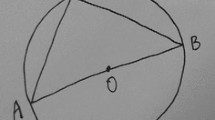Abstract
We propose an approach to generate geometric theorems from electronic images of diagrams automatically. The approach makes use of techniques of Hough transform to recognize geometric objects and their labels and of numeric verification to mine basic geometric relations. Candidate propositions are generated from the retrieved information by using six strategies and geometric theorems are obtained from the candidates via algebraic computation. Experiments with a preliminary implementation illustrate the effectiveness and efficiency of the proposed approach for generating nontrivial theorems from images of diagrams. This work demonstrates the feasibility of automated discovery of profound geometric knowledge from simple image data and has potential applications in geometric knowledge management and education.
Similar content being viewed by others
References
Avigad, J., Dean, E., Mumma, J.: A formal system for Euclid’s Elements. Rev. Symbolic Logic 2(4), 700–768 (2009)
Balbiani, P., Fariñas del Cerro, L.: Diagrammatic reasoning in projective geometry. In: Ohlbach, H.J., Reyle, U.(eds.) Logic, Language and Reasoning. Trends in Logic, vol.5, pp. 99–114. Kluwer, Dordrecht (1999)
Botana, F.: A web-based intelligent system for geometric discovery. In: Computational Science – ICCS 2003, LNCS 2657, pp. 801–810. Springer, Berlin Heidelberg (2003)
Chen, T.C., Chung, K.L.: A new randomized algorithm for detecting lines. Real-Time Imaging 7(6), 473–481 (2001)
Chen, T.C., Chung, K.L.: An efficient randomized algorithm for detecting circles. Comp. Vision Image Underst. 83(2), 172–191 (2001)
Chou, S.-C., Gao, X.-S.: Automated reasoning in geometry. In: Handbook of Automated Reasoning, vol. I, pp. 712–734. Elsevier, North Holland (2001)
Chou, S.-C., Gao, X.-S., Zhang, J.-Z.: A deductive database approach to automated geometry theorem proving and discovering. J. Autom. Reason. 25(3), 219–246 (1996)
Chou, S.-C., Lin, D.: Wu’s method for automated geometry theorem proving and discovering. In: Gao, X.-S., Wang, D. (eds.) Mathematics Mechanization and Applications, pp. 125–146. Academic Press, London (2000)
Dalzotto, G., Recio, T.: On protocols for the automated discovery of theorems in elementary geometry. J. Autom. Reason. 43(2), 203–236 (2009)
Duda, R.O., Hart, P.E.: Use of the Hough transformation to detect lines and curves in pictures. Comm. ACM 15(1), 11–15 (1972)
Fernandes, L.A.F., Oliveira, M.M.: Real-time line detection through an improved Hough transform voting scheme. J. Pattern Recogn. Soc. 41(1), 299–314 (2005)
Galambos, C., Kittler, J., Matas, J.: Gradient based progressive probabilistic Hough transform. Vision Image Signal Process. 148(3), 158–165 (2001)
Ida, T., Kasem, A., Ghourabi, F., Takahashi, H.: Morley’s theorem revisited: Origami construction and automated proof. J. Symb. Comput. 46(5), 571–583 (2011)
Kortenkamp, U.: Foundations of dynamic geometry. Ph.D. thesis ETH Zürich, pp. 60–72 (1999)
Magaud, N., Narboux, J., Schreck, P.: Formalizing projective plane geometry in Coq. In: Automated Deduction in Geometry, LNAI 6301, pp. 141–162. Springer, Berlin Heidelberg (2011)
Matas, J., Galambos, C., Kittler, J.: Robust detection of lines using the progressive probabilistic Hough transform. Comp. Vision Image Underst. 78(1), 119–137 (2000)
Montes, A., Recio, T.: Automatic discovery of geometry theorems using minimal canonical comprehensive Gröbner systems. In: Automated Deduction in Geometry, LNAI 4869, pp. 113–138. Springer, Berlin Heidelberg (2007)
Quaresma, P.: Thousands of geometric problems for geometric theorem provers (TGTP). In: Automated Deduction in Geometry, LNAI 6877, pp. 169–181. Springer, Berlin Heidelberg (2011)
Quaresma, P., Janičić, P.: GeoThms — A web system for Euclidean constructive geometry. Electron. Notes Theor. Comput. Sci. 174(2), 35–48 (2007)
Wang, D.: Elimination procedures for mechanical theorem proving in geometry. Ann. Math. Artif. Intell. 13(1–2), 1–24 (1995)
Wang, D.: Geometry machines: from AI to SMC. In: Calmet, J., Campbell, J.A., Pfalzgraf, J. (eds.) Artificial Intelligence and Symbolic Mathematical Computation. LNCS 1138, pp. 213–239. Springer, Berlin Heidelberg (1996)
Wang, D.: Elimination methods. Springer, Wien New York (2001)
Wilson, S., Fleuriot, J.D.: Combining dynamic geometry, automated geometry theorem proving and diagrammatic proofs. In: Proceedings of the European Joint Conferences on Theory and Practice of Software (ETAPS), Satellite Workshop on User Interfaces for Theorem Provers (UITP), Edinburgh, UK (2005)
Wu, W.-t.: Mechanical theorem proving in geometries: Basic principles (translated from the Chinese by X. Jin and D. Wang). Springer, Wien New York (1994)
Yano, K.: The famous theorems of geometry (Chinese edition, translated by Y. Chen). Shanghai Scientific and Technical Publishers (1986)
Ye, Z., Chou, S.-C., Gao, X.-S.: Visually dynamic presentation of proofs in plane geometry. J. Autom. Reason. 45(3), 213–241 (2010)
Yuen, H.K., Princen, J., Illingworth, J., Kittler, J.: Comparative study of Hough transform methods for circle finding. Image Vision Comput. 8(1), 71–77 (1990)
Zhang, T.Y., Suen, C.Y.: A fast parallel algorithm for thinning digital patterns. Comm. ACM 27(3), 236–239 (1984)
Epsilon, http://www-polsys.lip6.fr/wang/epsilon/. Accessed May 23 2014
Gaussian smoothing, http://en.wikipedia.org/wiki/Gaussian_blur. Accessed May 23 2014
GeoGebra, http://www.geogebra.org/cms/. Accessed May 23 2014
GEOTHER, http://www-polsys.lip6.fr/wang/GEOTHER/. Accessed May 23 2014
List of interactive geometry software, http://en.wikipedia.org/wiki/List_of_interactive_geometry_software. Accessed May 23 2014
OpenCV, http://opencv.org/. Accessed May 23 2014
Author information
Authors and Affiliations
Corresponding author
Rights and permissions
About this article
Cite this article
Chen, X., Song, D. & Wang, D. Automated generation of geometric theorems from images of diagrams. Ann Math Artif Intell 74, 333–358 (2015). https://doi.org/10.1007/s10472-014-9433-7
Published:
Issue Date:
DOI: https://doi.org/10.1007/s10472-014-9433-7




